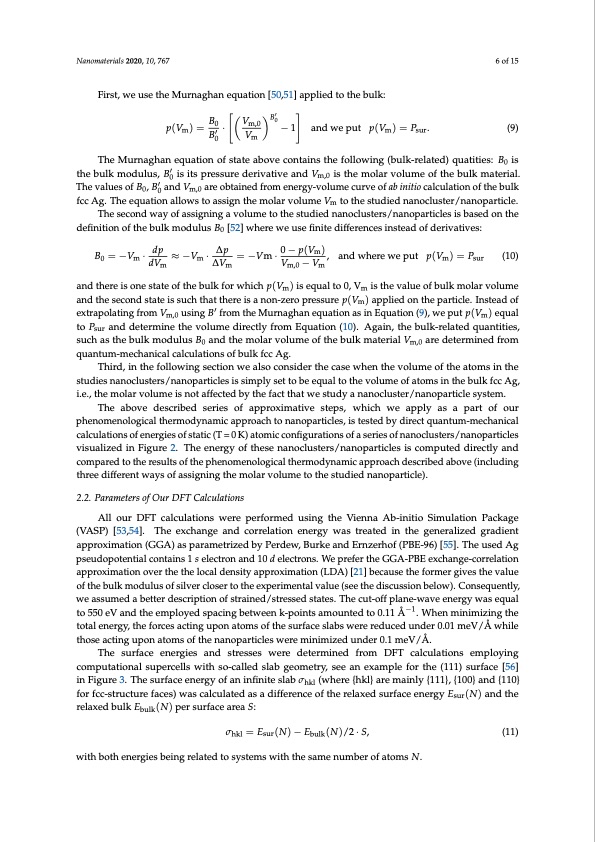
PDF Publication Title:
Text from PDF Page: 006
Nanomaterials 2020, 10, 767 6 of 15 First, we use the Murnaghan equation [50,51] applied to the bulk: B V B 0′ p(Vm)= 0 · m,0 −1 andweput p(Vm)=Psur. (9) B0′ Vm The Murnaghan equation of state above contains the following (bulk-related) quatities: B0 is the bulk modulus, B0′ is its pressure derivative and Vm,0 is the molar volume of the bulk material. The values of B0, B0′ and Vm,0 are obtained from energy-volume curve of ab initio calculation of the bulk fcc Ag. The equation allows to assign the molar volume Vm to the studied nanocluster/nanoparticle. The second way of assigning a volume to the studied nanoclusters/nanoparticles is based on the definition of the bulk modulus B0 [52] where we use finite differences instead of derivatives: B0 =−Vm· dp ≈−Vm· ∆p =−Vm·0−p(Vm), andwhereweput p(Vm)=Psur (10) dVm ∆Vm Vm,0 − Vm and there is one state of the bulk for which p(Vm) is equal to 0, Vm is the value of bulk molar volume and the second state is such that there is a non-zero pressure p(Vm) applied on the particle. Instead of extrapolating from Vm,0 using B′ from the Murnaghan equation as in Equation (9), we put p(Vm) equal to Psur and determine the volume directly from Equation (10). Again, the bulk-related quantities, such as the bulk modulus B0 and the molar volume of the bulk material Vm,0 are determined from quantum-mechanical calculations of bulk fcc Ag. Third, in the following section we also consider the case when the volume of the atoms in the studies nanoclusters/nanoparticles is simply set to be equal to the volume of atoms in the bulk fcc Ag, i.e., the molar volume is not affected by the fact that we study a nanocluster/nanoparticle system. The above described series of approximative steps, which we apply as a part of our phenomenological thermodynamic approach to nanoparticles, is tested by direct quantum-mechanical calculations of energies of static (T = 0 K) atomic configurations of a series of nanoclusters/nanoparticles visualized in Figure 2. The energy of these nanoclusters/nanoparticles is computed directly and compared to the results of the phenomenological thermodynamic approach described above (including three different ways of assigning the molar volume to the studied nanoparticle). 2.2. Parameters of Our DFT Calculations All our DFT calculations were performed using the Vienna Ab-initio Simulation Package (VASP) [53,54]. The exchange and correlation energy was treated in the generalized gradient approximation (GGA) as parametrized by Perdew, Burke and Ernzerhof (PBE-96) [55]. The used Ag pseudopotential contains 1 s electron and 10 d electrons. We prefer the GGA-PBE exchange-correlation approximation over the the local density approximation (LDA) [21] because the former gives the value of the bulk modulus of silver closer to the experimental value (see the discussion below). Consequently, we assumed a better description of strained/stressed states. The cut-off plane-wave energy was equal to 550 eV and the employed spacing between k-points amounted to 0.11 Å−1. When minimizing the total energy, the forces acting upon atoms of the surface slabs were reduced under 0.01 meV/Å while those acting upon atoms of the nanoparticles were minimized under 0.1 meV/Å. The surface energies and stresses were determined from DFT calculations employing computational supercells with so-called slab geometry, see an example for the (111) surface [56] in Figure 3. The surface energy of an infinite slab σhkl (where {hkl} are mainly {111}, {100} and {110} for fcc-structure faces) was calculated as a difference of the relaxed surface energy Esur(N) and the relaxed bulk Ebulk(N) per surface area S: σhkl = Esur(N) − Ebulk(N)/2 · S, (11) with both energies being related to systems with the same number of atoms N.PDF Image | Quantum-Mechanical of the Energetics of Silver Decahedron Nanoparticles

PDF Search Title:
Quantum-Mechanical of the Energetics of Silver Decahedron NanoparticlesOriginal File Name Searched:
nanomaterials-10-00767-v2.pdfDIY PDF Search: Google It | Yahoo | Bing
Turbine and System Plans CAD CAM: Special for this month, any plans are $10,000 for complete Cad/Cam blueprints. License is for one build. Try before you buy a production license. More Info
Waste Heat Power Technology: Organic Rankine Cycle uses waste heat to make electricity, shaft horsepower and cooling. More Info
All Turbine and System Products: Infinity Turbine ORD systems, turbine generator sets, build plans and more to use your waste heat from 30C to 100C. More Info
CO2 Phase Change Demonstrator: CO2 goes supercritical at 30 C. This is a experimental platform which you can use to demonstrate phase change with low heat. Includes integration area for small CO2 turbine, static generator, and more. This can also be used for a GTL Gas to Liquids experimental platform. More Info
Introducing the Infinity Turbine Products Infinity Turbine develops and builds systems for making power from waste heat. It also is working on innovative strategies for storing, making, and deploying energy. More Info
Need Strategy? Use our Consulting and analyst services Infinity Turbine LLC is pleased to announce its consulting and analyst services. We have worked in the renewable energy industry as a researcher, developing sales and markets, along with may inventions and innovations. More Info
Made in USA with Global Energy Millennial Web Engine These pages were made with the Global Energy Web PDF Engine using Filemaker (Claris) software.
Infinity Turbine Developing Spinning Disc Reactor SDR or Spinning Disc Reactors reduce processing time for liquid production of Silver Nanoparticles.
| CONTACT TEL: 608-238-6001 Email: greg@infinityturbine.com | RSS | AMP |